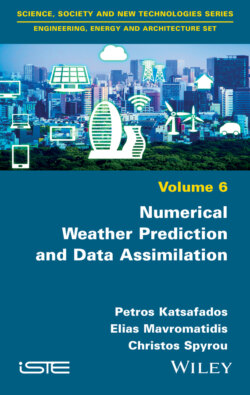Numerical Weather Prediction and Data Assimilation

Реклама. ООО «ЛитРес», ИНН: 7719571260.
Оглавление
Petros Katsafados. Numerical Weather Prediction and Data Assimilation
Table of Contents
List of Tables
List of Illustrations
Guide
Pages
Numerical Weather Prediction and Data Assimilation
Preface
Introduction
1. The Primitive Equations
1.1. Wind forecast equations (conservation of momentum)
1.1.1. Real forces
1.1.2. Apparent forces
1.1.3. Equation of motion
1.2. Continuity equation (conservation of mass)
1.3. Temperature forecast equation (conservation of energy)
1.4. Moisture forecast equation (conservation of water vapor)
1.5. Synopsis of equations
2. Solving Methods in NWP Models
2.1. Decomposition of variables – the perturbation method
Horizontal x-momentum equation
Horizontal y-momentum equation
Vertical z-momentum equation
Continuity equation
Thermodynamic energy equation
Moisture equation
2.1.1. Synoptic scale equations
Horizontal x-momentum equation
Horizontal y-momentum equation
Thermodynamic energy and moisture components
2.1.2. Mesoscale equations
Horizontal x-momentum equation
Horizontal y-momentum equation
Vertical wind component
Nondimensional pressure π
Thermodynamic energy equation
Moisture equation
2.2. Numerical solutions of partial differential equations
2.2.1. Computations by finite difference schemes
2.2.2. Derivation of finite difference representations
2.2.3. Methods for solving the advection–diffusion equation
2.2.3.1. Transient diffusion equation
Explicit schemes. Forward in time/central in space scheme (FTCS)
The Richardson method
Dufort–Frankel method
Implicit schemes. The Laasonen method
The Crank–Nicolson method
General formulation (β-method)
2.2.3.2. Transient convection (advection) equation
Explicit schemes. Euler forward in time and in space (FTFS) approximation
Euler forward in time and central in space (FTCS) approximation
Euler forward in time and backward in space (FTBS) approximations (first-order upwind method)
Lax method
Midpoint leapfrog method
Lax–Wendroff method
MacCormack method
Second-order upwind method
Implicit schemes. Euler implicit method
Leapfrog method
Crank–Nicolson method
2.2.3.3. Nonlinear problems
Forward in time/central in the space scheme (FTCS) method
Lax method
MacCormack method
2.2.3.4. Burgers’ equation
Forward in time/central in space (FTCS) explicit scheme (forward Euler scheme)
FTBCS explicit scheme
Dufort–Frankel explicit scheme
MacCormack explicit scheme
First order in time and second order in space implicit scheme
Crank–Nicolson semi-implicit scheme
Leapfrog scheme
Matsuno scheme
Heun scheme
Adams–Bashforth scheme
2.3. Time splitting
3. Domain Structures and Boundary Conditions
3.1. Horizontal grid structure and resolution
3.2. The vertical coordinate system
3.2.1. Terrain-following coordinate system
Mesoscale variables
Synoptic scale variables
3.3. Boundary conditions
3.3.1. Lateral boundary conditions
3.3.2. Upper (top) boundary conditions
3.3.3. Lower (bottom) boundary conditions
3.3.3.1. Water bodies
3.3.3.2. Land bodies
3.3.3.3. Surface energy balance
Shortwave radiation
Long-wave radiation
The terrain effects on radiation
Vegetation
3.4. Design of a simulation
4. Introduction to Data Assimilation
4.1. Successive correction methods
4.2. Least square method
4.3. Variational approach
4.4. Generalization of the methods
5. Desert Dust Modeling
5.1. Dust uptake mechanisms formulation
5.2. Dust advection and deposition
5.3. Parameterization of the dust feedbacks on climate
6. Simulations of Extreme Weather and Dust Events. 6.1. Case study 1: numerical simulation of a Mediterranean cyclone and its sensitivity on lower boundary conditions
6.1.1. Description of the synoptic conditions
6.1.2. Design of the simulations
6.1.3. Analysis of the numerical simulations
6.2. Case study 2: nowcasting an extreme precipitation event
6.2.1. Synoptic analysis of the event
6.2.2. Nowcasting methodology and results
6.3. Case study 3: seasonal predictability of a large-scale heat wave
6.3.1. Description of the synoptic conditions
6.3.2. Model description and methodology
6.3.3. Predictability assessment
6.4. Numerical study of a severe desert dust storm over Crete
Appendix 1
Appendix 2. A2.1. Turbulent diffusion parameterizations
A2.2. Planetary boundary layer (PBL) parameterization
A2.2.1. Surface layer parameterization
A2.2.2. Viscous sublayer parameterization
A2.2.3. Transition layer parameterization
A2.3. Transforming the vertical coordinate
References
Index. A, B, C
D, E, F
G, H, I
K, L, M
N, O, P
Q, R, S
T, U, V, W
WILEY END USER LICENSE AGREEMENT
Отрывок из книги
Engineering, Energy and Architecture Set
.....
Volume 6
Petros Katsafados
.....